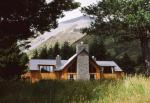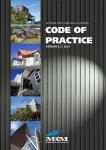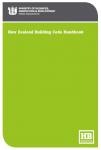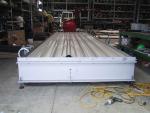Standards and the NZMRM
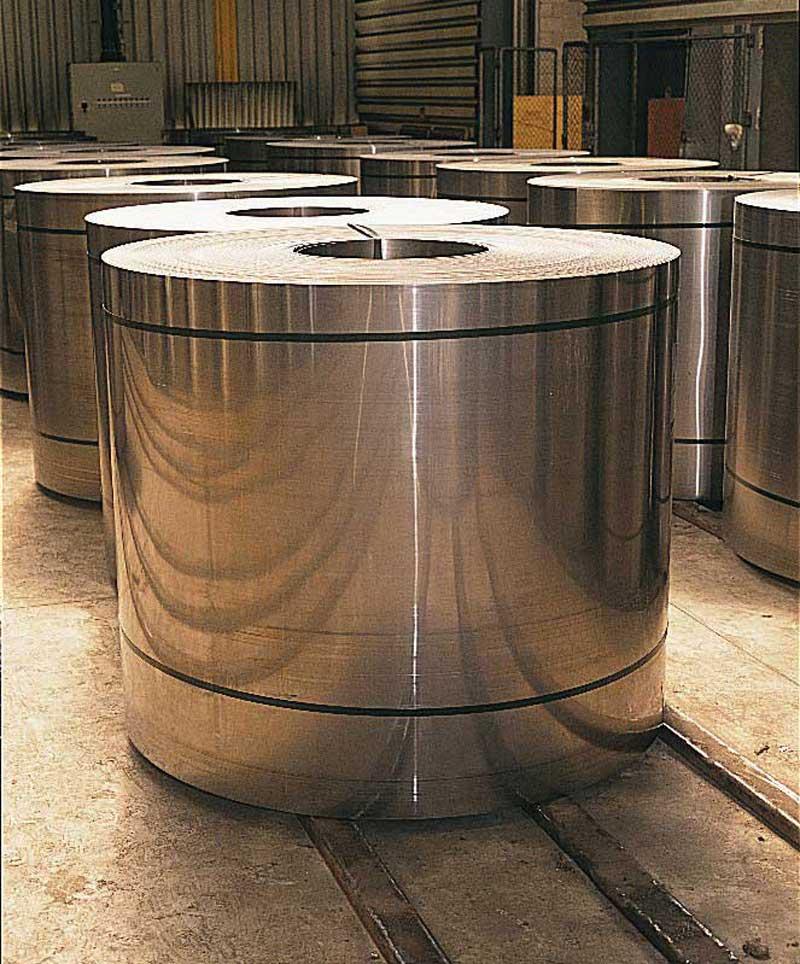
In the last issue, we had an update from Standards NZ about how the Standards development process works and how building industry Standards relate to the NZ Building Code (NZBC). In the introduction, it was indicated that we would discuss how Standards (and standards) affect the metal roofing (and rain water goods) manufacturing industry, and also what NZMRM’s involvement in the development of Standards has been over the years.
Note: in this discussion, “standard” means a prescribed level of composition or performance established by an organisation relating to items to be controlled; “Standard” means a standard developed, published and maintained by a Standards organisation, e.g. Standards New Zealand.
So, first, what Standards actually affect manufacture and installation of metal roofing?
Perhaps fortunately for NZMRM members, most of the Standards and requirements for compliance revolve around the materials we use, both in manufacture and in installation. This means we rely on the suppliers to ensure compliance with the appropriate Standards. The effect that conversion of these materials into finished metal roof and wall cladding has is not generally covered by Standards except those relating to physical performance.
Indeed, probably the primary consideration for manufacturers of finished roofing is the choice of raw material based on the end use of the product, provision of the correct material for the end use, and assurance by means of standards that these materials do what they are stated to do.
Standards
However, while most of the Standards that do
affect the final performance of our products are involved before we get our raw materials, manufacturers and specifiers still need to understand what these are and how compliance with such Standards can provide the performance we require and expect, and that our customers rely on us to provide. Users of NZMRM made products should understand what Standards cover the products they are buying, use this information in product selection, and look for demonstration of compliance.
Unfortunately, virtually all of the physical properties we rely on in our raw materials are more or less invisible, and mostly not able to be determined just by handling the materials. So, as well as Standards to specify these properties and for test methods to assess the compliance of the materials with these properties, we need some assurance that the materials actually comply with the Standards.
Note that Standards for materials are usually separated into two or more areas – the product and performance requirements to one Standard using test methods described in different Standards. Keeping these aligned can be difficult.
Roof and wall cladding products.
There are basically four properties we are concerned about which are covered by Standards, either joint New Zealand/Australian or Australian. There are several European (EN) or ISO standards which cover the same properties and which are similar to AS or AS/NZS, but since metal roofing is such a major aspect of all types of building in New Zealand and Australia compared to Europe – and since we are in New Zealand not Europe – we only use Australasian Standards.
Inadequate quality of any of these properties can cause failure, either sooner or later. These properties are –
Physical performance provided by a combination of;
- Thickness of the base steel;
- Strength of the base steel; and
Durability performance provided by the base and any coatings ;
- Corrosion resistance/durability of the metallic base; and
- Durability of any paint coating either pre- or post-forming.
Physical performance
Thickness (and other dimensions) of the base steel
In NZ for any kind of dwelling (i.e. other than sheds) the minimum thickness for use in roll-formed cladding is required by the NZBC to be 0.40 mm. In fact, currently 0.55 mm is more commonly used. The thickness determines the span possible and the ability to withstand imposed loads (and of course the cost). For metal tiles the minimum thickness is 0.39 mm.
The tolerances for this property are covered by AS/NZS 1365:1996 – Tolerances for flat-rolled steel products. This standard also specifies tolerances for width, length, flatness, edge-camber and out- of- square compliance with all of which properties is necessary to be able to roll-form cladding properly (or at all).
These properties for aluminium coil are covered by AS/NZS 1734:1997. Aluminium and aluminiumalloys—Flat sheet, coiled sheet and plate.
Strength of the metallic coated steel
This property is assessed by tensile strength of the material expressed as minimum mPa (megaPascals) GXXX to failure, and is measured by methods described in AS 1391:2007 – Metallic materials – Tensile testing at ambient temperature. Steel-based products used for cladding in New Zealand are either nominally G300 or G550 (“high tensile”) mPa. G300 is used for forming tiles or curved roof sections or where greater ductility is required.
Most steel used for roof and wall cladding in NZ is nominally G550 although this often has actual strength up to 700 mPa.
Aluminium coil is softer and has lower tensile strength, which is also covered in AS/NZS 1734:1997.
Thickness and strength go together in creating the actual physical performance of the cladding and not meeting both thickness and strength standards can lead to premature wind uplift failure of the roof cladding and/or installation and foot traffic damage. Typically, these are specified together e.g. 0.55mm G550 - “Product name”.
Physical properties of finished products are covered by AS 1562.1:1992 – Design and Installation of Sheet Roof and Wall cladding – Part 1 Metal. (Currently under revision). Actual performance testing of finished product for wind load resistance and traffic ability is provided by testing to AS 4040.1 (Concentrated load) and .2 (Wind load) and the NZMRM test laboratory can test products to these standards or other methods and provide performance outcomes.
Durability Performance
Corrosion resistance – for steel this is created by a metallic coating of the base metal (or use of metal with greater natural corrosion resistance e.g. aluminium).
The predominant material for roof and wall cladding, used in NZ and also made here is Zincalume ® which has a coating of aluminium and zinc and which is only legitimately produced by plants licensed to BIEC (the original developer). Product cannot legally be called Zincalume® if it is not coated in a licensed plant. Zincalume ® is made by NZ Steel and painted by both NZ Steel and Pacific Coil Coaters. The coating weight of Zincalume® made in NZ is 150 g/m² or 200 g/m².
The corrosion resistance of this coating is created by a combination of the inert oxide coating formed on the aluminium (which makes up nearly 80% of the metallic coating by volume), and the sacrificial protection provided by the zinc content.
In New Zealand, we also see galvanised steel (zinc coating) and a product called “ZAM” (zinc aluminium magnesium) which is also painted by Pacific Coil Coaters.
Metallic coatings and their properties are covered in AS 1397:2011 – Continuous hot-dip metallic coated steel sheet and strip – coatings of zinc and zinc alloyed with aluminium and magnesium. This designates steel that can be coated under the Standard and then lists six coatings with a one or two letter code, and specifies acceptable coating weights to be used for external exposure -
- Zinc (Z) – which is what we call “Galvanised” – not now used for roofing
- Zinc coating as a zinc/iron alloy (ZF) – also called Galvannealed
- Zinc/Aluminium (ZA) – also called “Galfan”, not used in New Zealand
- Zinc/Aluminium/Magnesium (ZM) – which is used in NZ under the name “ZAM”
- Aluminium/Zinc (AZ) – which we call in Australasia “Zincalume ®” (elsewhere “Galvalume or Aluzinc”)
- Aluminium/Zinc/Magnesium (AM) – launched in Australia recently
Of these the majority of roof and wall cladding and rainwater goods and tiles in New Zealand are made from Zincalume ®, either painted or unpainted.
Lack of corrosion resistance can be caused by inadequate weight or inferior quality of coating or coating not being what it is claimed to be, and any of these can cause premature corrosion failure even within the modest life of 15 years required by the NZBC, and well below market expectations. Some BIEC licensed overseas plants make lower metallic coating weight materials for less demanding applications, and such products should not be used for external application even if the actual coating material is correct.
The coating weight of metallic coatings can be measured relatively easily by methods described in AS 1397, and this is a measure of the likely corrosion resistance but the actual corrosion resistance of coated product can also be confirmed by exposure to a corrosive environment either natural or accelerated described in AS/NZS 2728:2013, below.
Paint durability
The final property is paint quality. Much of the product used for roof and wall cladding and rainwater goods is coated with paint or other coatings which provide enhanced appearance, and which may be purchased specifically for appearance. This property is the most difficult to measure, but the quickest to fail and the most noticeable when it does. The vast majority of failures attributed to painted steel products are paint failure leading to very quick visible fading, chalking and colour change, and complaints, sometimes within as little as 12 months.
The joint standard for coating performance is AS/NZS 2728:2013 - Pre-finished/pre-painted products for internal/external building applications – Performance requirements. It has a number of performance requirements but for paint colour durability this only specifies 4 years’ exposure at nominated sites and then assessment of colour change. This is in any case only an informative test in 2728 and there is no accelerated test detailed, although these do exist as ASTMs.
There are two ways to assess paint performance – real life exposure at a severe site (normally the commercial site at Allunga near Townsville or others listed in 2728) or accelerated UV exposure using one of the accepted standard methods e.g. a QUV cabinet and one of several test protocols.
AS/NZS 2728 also includes normative corrosion testing of painted products, in real or accelerated environments.
Other standards
In addition to Standards published by Standards organisations there are other published composition or performance requirements. Unlike Standards which need to be purchased these other standards are usually free to download.
NZ Building Code
While adoption of Standards may not be mandatory, compliance with the NZBC is for most buildings. The controlling entity, MBIE (Ministry of Business, Innovation and Employment) – which now covers Building controls and Standards New Zealand, issues methods of compliance called Acceptable Solutions, aligning with which is deemed to comply with the NZBC. Clause E2 of the NZBC which covers the external envelope, including roof and wall cladding, has a massive AS, E2/AS1 which effectively is a set of standards. Some of these call up actual Standards, some don’t. The NZBC and Acceptable Solutions are available as free downloads from the MBIE website.
(The Australian Building Codes Board – ABCB – also has non-Standard compliance requirements).
NZMRM Standards
To simplify all of the above NZMRM has produced industry specifications covering metallic coated steel, and pre- and post- painted metallic coated steel. These generally incorporate reference to the Standards listed above in one package.
In particular, the UV levels in New Zealand and Australia cause paint which performs well elsewhere to fail quickly, and coupled with the high use level of coil-coated steel products the use of painted coil which has not actually been tested and proved adequate has serious market implications for all such product.
The NZMRM specification for pre-painted coil has modified AS/NZS 2728:2013 by, among other things, requiring the UV exposure test to be Normative Not Informative.
The NZMRM Code of Practice discusses all of these properties in detail.
These specifications and the CoP are available as free downloads on the NZMRM website.
Quality Assurance
It’s all very well having Standards for product performance and testing, but unless compliance is regularly assessed and certified, users have no idea if their actual supply complies as specified. This is particularly true for the materials used for roof and wall cladding. Samples may comply with the Standard, but production may not. Fortunately, this was recognised as needing attention back in the 1990s and the ISO 9000 family of standards - Quality Management Systems was the result. Suppliers should be able to offer certification of their quality systems to ISO 9001, which means their production is covered by an approved and inspected quality management system. Purchasers should ensure suppliers can offer this.
Summary
In spite of many specifiers and users being unaware of it, the products of NZMRM members are covered by Standards, and demanding and ensuring compliance with these Standards and proper specification of the correct product for the location will provide assurance of maximum performance. MBIE and the New Zealand building industry is currently expressing concern over the import and use of sub-standard (or actually no-standard) building materials potentially leading to the sort of catastrophic and very costly failures that have been experienced in Australia. Demanding verified compliance with Standards is part of avoiding such issues.
Next time we will discuss Standards which NZMRM representatives have been and are working on and NZMRM’s long-term contribution to the Standards development process.
Stuart Hayman

